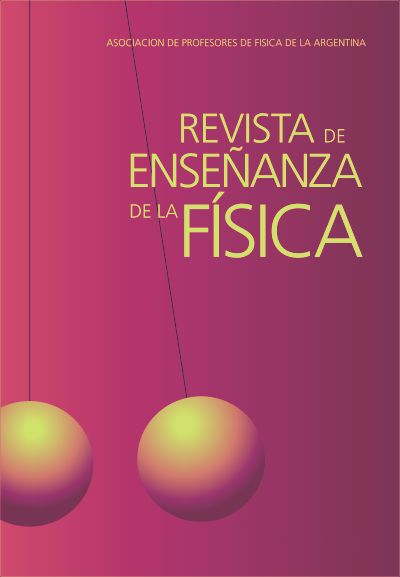Teaching physics at university in times of pandemics: challenges and learnings
DOI:
https://doi.org/10.55767/2451.6007.v34.n2.39488Keywords:
Physics in pandemics, On-line lectures, Agile methodology, Systematic innovationAbstract
This article recounts our experience adapting the Physics lecturing to virtual modality at Instituto de Ciencias Polares, Universidad Nacional de Tierra del Fuego (Argentina) due to the covid-19 pandemics in the years 2020 and 2021. Our goal was preserving the essence of the in-person modality: interactive engagement focusing on group work and debates, so virtuality posed a significant challenge. To face it, we assembled an interdisciplinary team and the agile methodology was adopted, complementing our usual implementation of systematic innovation. We suggest that from combining the in-person modality with tools acquired during confinement a more robust Physics course will arise, with a far more consistent formative evaluation scheme.
References
Badagnani, D., Petrucci, D., y Cappannini, O. (2017). Evidence on the coherence–pieces debate from the force concept inventory. European Journal of Physics, 39(1), 015705.
Badagnani, D., Terzzoli, M. C. y Schlaps, E. (2019). Evidencia experimental de la dualidad de recursos en el conocimiento privado inicial de la mecánica. Revista de Enseñanza de la Física, 31(extra), 21-28. Recuperado a partir de https://revistas.unc.edu.ar/index.php/revistaEF/article/view/26522.
Badagnani, D., Terzzoli, M. C., Schlaps, E. y Petrucci, D. (2020). Patrón de respuestas a preguntas conceptuales sobre Mecánica Newtoniana: implicancias para el aprendizaje. Revista de Enseñanza de la Física, 32(extra), 25-32. Recuperado a partir de https://revistas.unc.edu.ar/index.php/revistaEF/article/view/30963.
Chan, F. K. y Thong, J. Y. (2009). Acceptance of agile methodologies: A critical review and conceptual framework. Decision support systems, 46(4), 803-814.
Flako fuentes. (2013, octubre 7). Video censurado varias veces ENERGÍA GRATIS, ENERGÍA LIBRE, motor magnético. [Video] YouTube. https://www.youtube.com/watch?v=NVk-HdQos5k
García, A. M. D. y Cuello, R. O. (2009). Interacción entre la evaluación continua y la autoevaluación formativa: La potenciación del aprendizaje autónomo. Revista de docencia universitaria, 7(4).
Hake, R. R. (1998). Interactive-engagement versus traditional methods: A six-thousand-student survey of mechanics test data for introductory physics courses. American Journal of Physics, 66(1), 64-74.
Institweet. (2011, septiembre 30). Física dinámica balanza en un ascensor. [Video] YouTube. https://www.youtube.com/watch?v=ELwCfLCyI60
Jiménez, M. R. y Petrucci, D. (2004). La innovación sistemática: un análisis continuo de la práctica docente universitaria de ciencias. Revista Investigación en la Escuela, 52, 79-89.
Nut-T. (2014, septiembre 29). Estudio del peso aparente en un ascensor. [Video] YouTube. https://www.youtube.com/watch?v=buuSnImoKSE
Petrucci, D. (2009). El Taller de Enseñanza de Física de la UNLP como innovación: diseño, desarrollo y evaluación. Tesis doctoral en Didáctica de las Ciencias Naturales de la Universidad de Granada.
Ramos, M. (2016, 25 de abril). Peso Aparente [Video]. YouTube. http://youtube.com/watch?v=wxRohmlAo8I
Salza, P., Musmarra, P., y Ferrucci, F. (2019). Agile methodologies in education: A review. Agile and lean concepts for teaching and learning, 25-45.
Downloads
Published
Issue
Section
License

This work is licensed under a Creative Commons Attribution-NonCommercial-NoDerivatives 4.0 International License.
Aquellos autores/as que tengan publicaciones con esta revista, aceptan los términos siguientes:Los autores/as conservarán sus derechos de copiar y redistribuir el material, bajo los términos estipulados en la Licencia de reconocimiento, no comercial, sin obras derivadas de Creative Commons que permite a terceros compartir la obra bajo las siguientes condiciones:
- Reconocimiento — Debe reconocer adecuadamente la autoría, proporcionar un enlace a la licencia e indicar si se han realizado cambios. Puede hacerlo de cualquier manera razonable, pero no de una manera que sugiera que tiene el apoyo del licenciador o lo recibe por el uso que hace.
- NoComercial — No puede utilizar el material para una finalidad comercial.
- SinObraDerivada — Si remezcla, transforma o crea a partir del material, no puede difundir el material modificado.
- Los autores/as podrán adoptar otros acuerdos de licencia no exclusiva de distribución de la versión de la obra publicada (p. ej.: depositarla en un archivo telemático institucional o publicarla en un volumen monográfico) siempre que se indique la publicación inicial en esta revista.
- Se permite y recomienda a los autores/as difundir su obra a través de Internet (p. ej.: en archivos telemáticos institucionales o en su página web) antes y durante el proceso de envío, lo cual puede producir intercambios interesantes y aumentar las citas de la obra publicada. (Véase El efecto del acceso abierto).










